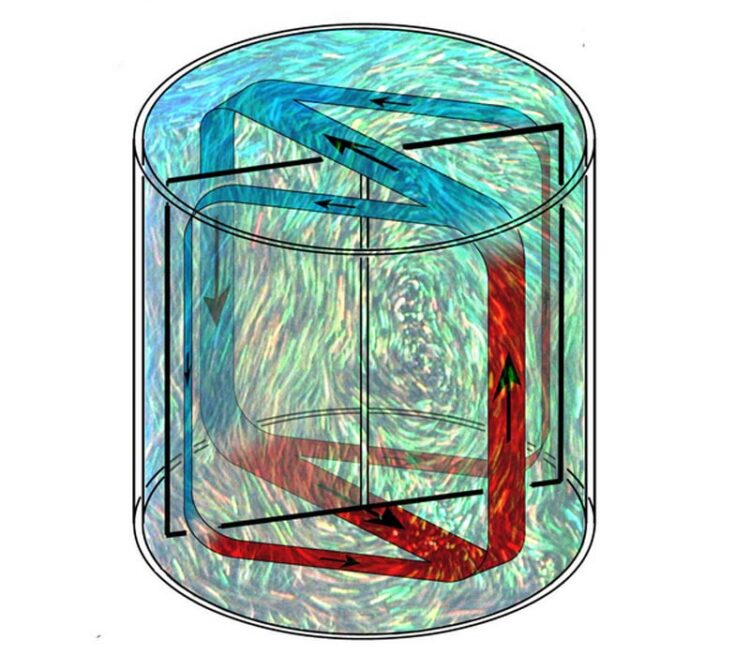Physicists take the temperature of fluid flows

A recent experimental study, inspired by the super-rotation of the Earth's solid core, shows when turbulence flows contained in a cylinder interact with a free body a surprisingly smooth rotation is observed. The red (warm) and blue (cold) ribbons represent water flows.
Image by Kaizhe Wang and Jun Zhang
… and discover new role for turbulence.
Turbulent flows take on a surprising spin in an experiment inspired by the Earth’s core.
A team of physicists has discovered a new role for a specific type of turbulence—a finding that sheds light on fluid flows ranging from the Earth’s liquid core to boiling water.
The research, which appears in the journal Proceedings of the National Academy of Sciences, centered on turbulent convection—the movement of fluid when heated from below.
“Our experiments reveal intricate movements between a free-moving body and thermal convective flows,” says Jun Zhang, a professor of mathematics and physics at New York University and NYU Shanghai, the paper’s senior author.
The study, which also included Kaizhe Wang, a researcher in NYU’s Department of Physics, focused specifically on Rayleigh–Bénard convection—a type of convection driven by temperature differences.
In their experiments, conducted in the Joint Research Institute of NYU Shanghai, the paper’s authors used a cylindrical container filled with water, then heated it from the bottom, creating convective flows. The resulting turbulent flows interacted with a suspended solid (a rectangular panel) that moved freely inside the container—a setting that allowed the researchers to better study how turbulent flows interact with solid structures within.
“Surprisingly, the system becomes somewhat well-behaved,” notes Zhang. “We observed a smooth rotation of the flows and the free solid.”
Their results showed that turbulent convection powered flows, together with the solid, can move in two directions—one clockwise and the other counterclockwise—with the co-rotational speed increasing with the intensity of the convection. More than that, their rotation can sometimes switch directions, caused by the turbulence.
“The research, inspired by the rotation of Earth’s inner core as it interacts with the convective liquid core, captures the interaction between a turbulent flow and a freely moving body within the flow,” explains Zhang. “The findings confirm that turbulence can be tamed by interacting with solids. It also reminds us that the power of thermal convection might play more important roles inside our planet Earth.”
Journal: Proceedings of the National Academy of Sciences
Method of Research: Experimental study
Article Title: Persistent Co-Rotation of the Large-Scale Flow of Thermal Convection and an Immersed Free Body
Article Publication Date: 15-May-2023
Media Contact
James Devitt
New York University
james.devitt@nyu.edu
Office: United States
Cell: 914-522-3774
All latest news from the category: Physics and Astronomy
This area deals with the fundamental laws and building blocks of nature and how they interact, the properties and the behavior of matter, and research into space and time and their structures.
innovations-report provides in-depth reports and articles on subjects such as astrophysics, laser technologies, nuclear, quantum, particle and solid-state physics, nanotechnologies, planetary research and findings (Mars, Venus) and developments related to the Hubble Telescope.
Newest articles

Innovative 3D printed scaffolds offer new hope for bone healing
Researchers at the Institute for Bioengineering of Catalonia have developed novel 3D printed PLA-CaP scaffolds that promote blood vessel formation, ensuring better healing and regeneration of bone tissue. Bone is…

The surprising role of gut infection in Alzheimer’s disease
ASU- and Banner Alzheimer’s Institute-led study implicates link between a common virus and the disease, which travels from the gut to the brain and may be a target for antiviral…

Molecular gardening: New enzymes discovered for protein modification pruning
How deubiquitinases USP53 and USP54 cleave long polyubiquitin chains and how the former is linked to liver disease in children. Deubiquitinases (DUBs) are enzymes used by cells to trim protein…


